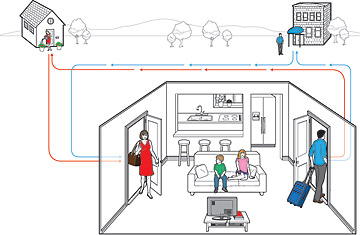
When Jon Marden and Ana Elizabeth decided to split in 2005 after 13 years of marriage, they both moved out of the house they shared in the woods near Santa Cruz, Calif. Their three children, however, stayed put. When it was Elizabeth's turn to look after the kids, she stayed with them. When it was their father's turn, she left and he took over.
This arrangement, sometimes known as nesting, has emerged over the past decade as an offshoot of the equal-custody, or co-parenting, trend. It requires what would seem to many splitting couples to be a mind-bogglingly amicable relationship and, usually, a robust pot of marital funds, since the number of homes expands from one to three: his, hers and the children's.
It's also an interesting sign of the way ending a marriage is changing, at least in certain spheres. Among educated and wealthy parents, who divorce less often than low-income couples, splits are managed so carefully, they're almost curated. Possibly because a lot of them were children of divorce, these parents are looking for new methods of minimizing the impact of their estrangement on their kids. Other families are trying it, lawyers say, because they can't afford to sell their homes.
There are no reliable figures on how widespread nesting is, maybe because it's often a temporary arrangement. And it's still unconventional enough that many people who do it aren't eager to talk about it. Those who are willing say that for their kids, not having to shuttle between parents or leave the home they've always known provides stability and continuity at a time of turmoil. "I didn't think my kids could deal with the stress of two different houses," says Elizabeth, 53, who continued to spend three or four days a week in the Marden family home until 2009. Neither she nor her ex was wealthy, so when not with the kids, he stayed with his new girlfriend and she stayed with friends or found house-sitting gigs.
The arrangement had unexpected upsides. For one, the children got to see their father more than before the divorce. "He reconnected with them," says Elizabeth, who stopped using Marden as her surname after the breakup. Meanwhile, she found that being in the house forced her to face up to her role in the breakdown of their marriage. "If I hadn't had to be in that environment, I never would have worked through that."
But she acknowledges it was a slog, especially at the beginning. There were flare-ups over laundry and groceries. And it was a little weird. Sometimes she walked in to find her ex had bought new furniture. "I was surrounded by things I'd had no say in choosing, in my home." (Marden declined to comment for this story.)
In rare instances, judges have ordered divorcing partners to set up nesting arrangements to avoid, as one Ontario judge put it, "treating children as Frisbees." To try to make nesting work in the absence of judges' dictates, couples tend to establish elaborate sets of rules about what or who is allowed in the shared home. Even so, there are developments that can't be legislated around, signs of an ex-spouse who's changing--a Milan Kundera book on the nightstand of an airport-novel reader or exotic cheeses in the fridge of a former Cracker Barrel fan. Or, of course, evidence of a new love.
